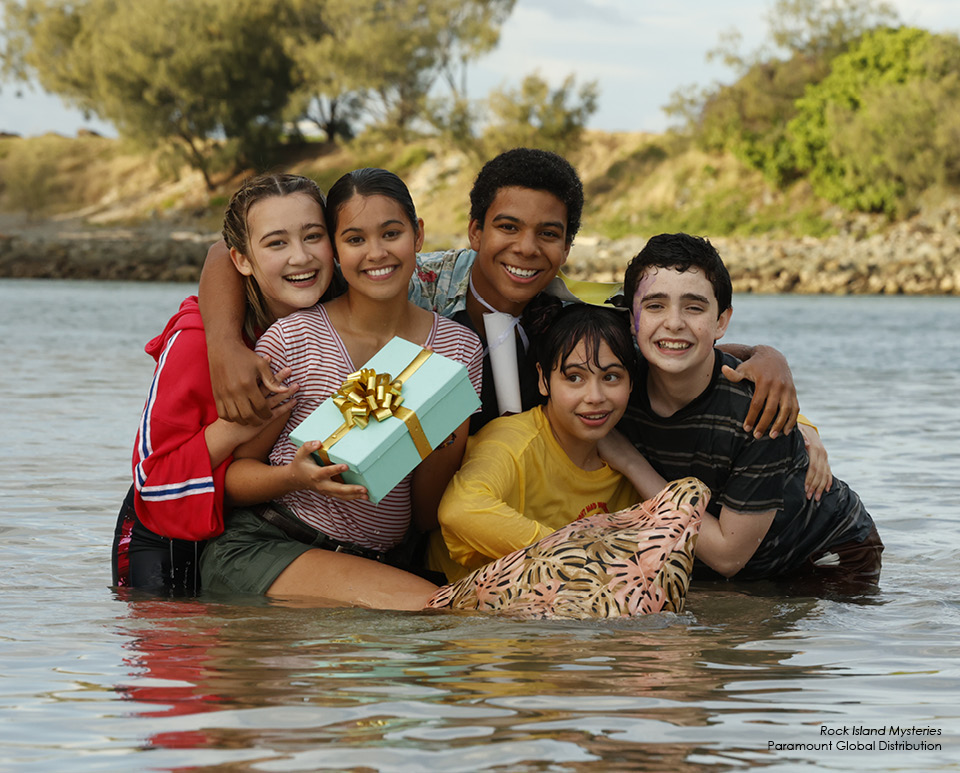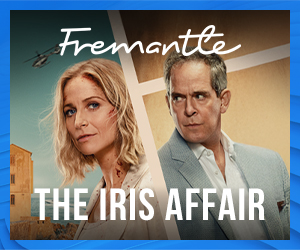
Kids rights holders and content distributors talk about monetising kids content, the changes they're seeing in buying patterns in Asia, discoverability, surfacing content, their favourite strategies for putting their shows in the right places at the right times, and other top-of-mind issues as the industry heads for Mip Junior (15-16 October 2022).
Did monetising kids content in Asia become more difficult this year?

"No not really, kids content is still in high demand and streamers are increasingly seeing the value of a robust kids offering, so the market has been buoyant." Lauren Marriott, SVP, Content Partnerships & Brand Strategy, Paramount Global Content Distribution
"Yes and no. On the one hand linear opportunities can sometimes be limited, with many channels suffering from budget cuts and an ever-changing media-landscape to compete with, but on the other AVOD exploitation at a local and global basis, both via local partner’s platforms as well as our own YouTube channels, has seen the balance maintained this year. Many streaming services seem to be re-evaluating their kids and family content strategy, with so many players in the market, and so this could result in financing some new IP in particular a little more challenging. From our experience, financing and monetising known-brands continues to be a success." Miguel Mestre, Senior Sales Manager, Aardman
“It’s no more difficult than it has been in past years. If anything there are more platforms and opportunities to distribute a streaming channel. The challenge for monetising kids content continues to be in the ad supported space, nonetheless, there are concerted efforts in the industry to grow and increase access to specifically kid and family appropriate advertising that I see as a positive sign for the future.” Luca Fiore, Director of Content, Macademia
“No, in general the opposite was true – streaming kids content increased during the pandemic and has continued to rise throughout 2022 so we’ve seen increased streaming revenue as well as traditional licensing deals.” Joe Barrett, Vice President of Sales, PBS International
"In terms of YouTube/ AVOD, it doesn't look like it will be more difficult this year than the previous one. If anything, the multi non-exclusive window opportunities are increasing with the launch of more AVOD platforms and FAST channels." Sophie ‘Kido’ Prigent, Global Head of Sales, Jetpack Distribution
"I would say monetising content can be easier now with so many streaming original opportunities, but retaining distribution rights, at least in the first window has become more challenging." Kerry Novick, VP Global Distribution, The Jim Henson Company
"I think it is always difficult to monetise kids content as there are more protection in place for this. Many advertisers are not allow to advertise so therefore it will be difficult be it now or in the future. I think to purely to focus on monetising on TV is not a way to go." Samantha Wong, Head of Global Division, Zoland Distribution
Do you think monetisation will become easier in 2023?
"I think whether is becomes easier or harder, we have to remain flexible and nimble about how we monetize content and remain open to new opportunities. We have to put shows where children are watching them and help them interact with shows as they want to interact with them. That’s how you build a successful franchise." Lauren Marriott, SVP, Content Partnerships & Brand Strategy, Paramount Global Content Distribution
“In some respects, it will become easier as the market sees more platforms emerging (AVOD, Fast channels, etc.) providing consumers with more choice; like short-form content. However, a steady pipeline of good content will always remain critical as viewers and buyers alike return to PBS Distribution for additional episodes and new programmes.” Joe Barrett, Vice President of Sales, PBS International
"Absolutely, particularly in what concerns more traditional linear channels, as there seems to be a slightly increased appetite with respect to 2021, which we hope will continue on its upward trend next year." Miguel Mestre, Senior Sales Manager, Aardman
“I do in the ad supported space for the reasons noted above. For subscription services and pay-tv, it will really depend on the consumer trends for each region/market and what kind of services consumers are gravitating towards.” Luca Fiore, Director of Content, Macademia
"Hopefully, as AVOD services promote themselves to keep up in an ever-more crowded market. And refine their interfaces and discoverability tools to retain viewers." Sophie ‘Kido’ Prigent, Global Head of Sales, Jetpack Distribution
"I think it will, as I see a trend of moving towards short-form, which is less expensive to produce, but is what kids want to watch. I believe the advent of FAST will also propel monetisation in ways we still can’t conceive." Kerry Novick, VP Global Distribution, The Jim Henson Company
"It has never been a breeze .. and its not going to get any easier especially with many digital players wanting revenue share model." Samantha Wong, Head of Global Division, Zoland Distribution
Are you seeing any significant changes in the way kids buyers are acquiring content in Asia?
"Somewhat significant changes now compared to how they were acquiring in 2021. There’s more appetite to study content in detail before deciding on a license or not, and there has certainly been more business achieved overall than last year, both in terms of linear and OTT. Miguel Mestre, Senior Sales Manager, Aardman
"I wouldn’t say significant changes, buyers are still looking for known IP and our Nick franchises are still in demand." Lauren Marriott, SVP, Content Partnerships & Brand Strategy, Para...
Kids rights holders and content distributors talk about monetising kids content, the changes they're seeing in buying patterns in Asia, discoverability, surfacing content, their favourite strategies for putting their shows in the right places at the right times, and other top-of-mind issues as the industry heads for Mip Junior (15-16 October 2022).
Did monetising kids content in Asia become more difficult this year?

"No not really, kids content is still in high demand and streamers are increasingly seeing the value of a robust kids offering, so the market has been buoyant." Lauren Marriott, SVP, Content Partnerships & Brand Strategy, Paramount Global Content Distribution
"Yes and no. On the one hand linear opportunities can sometimes be limited, with many channels suffering from budget cuts and an ever-changing media-landscape to compete with, but on the other AVOD exploitation at a local and global basis, both via local partner’s platforms as well as our own YouTube channels, has seen the balance maintained this year. Many streaming services seem to be re-evaluating their kids and family content strategy, with so many players in the market, and so this could result in financing some new IP in particular a little more challenging. From our experience, financing and monetising known-brands continues to be a success." Miguel Mestre, Senior Sales Manager, Aardman
“It’s no more difficult than it has been in past years. If anything there are more platforms and opportunities to distribute a streaming channel. The challenge for monetising kids content continues to be in the ad supported space, nonetheless, there are concerted efforts in the industry to grow and increase access to specifically kid and family appropriate advertising that I see as a positive sign for the future.” Luca Fiore, Director of Content, Macademia
“No, in general the opposite was true – streaming kids content increased during the pandemic and has continued to rise throughout 2022 so we’ve seen increased streaming revenue as well as traditional licensing deals.” Joe Barrett, Vice President of Sales, PBS International
"In terms of YouTube/ AVOD, it doesn't look like it will be more difficult this year than the previous one. If anything, the multi non-exclusive window opportunities are increasing with the launch of more AVOD platforms and FAST channels." Sophie ‘Kido’ Prigent, Global Head of Sales, Jetpack Distribution
"I would say monetising content can be easier now with so many streaming original opportunities, but retaining distribution rights, at least in the first window has become more challenging." Kerry Novick, VP Global Distribution, The Jim Henson Company
"I think it is always difficult to monetise kids content as there are more protection in place for this. Many advertisers are not allow to advertise so therefore it will be difficult be it now or in the future. I think to purely to focus on monetising on TV is not a way to go." Samantha Wong, Head of Global Division, Zoland Distribution
Do you think monetisation will become easier in 2023?
"I think whether is becomes easier or harder, we have to remain flexible and nimble about how we monetize content and remain open to new opportunities. We have to put shows where children are watching them and help them interact with shows as they want to interact with them. That’s how you build a successful franchise." Lauren Marriott, SVP, Content Partnerships & Brand Strategy, Paramount Global Content Distribution
“In some respects, it will become easier as the market sees more platforms emerging (AVOD, Fast channels, etc.) providing consumers with more choice; like short-form content. However, a steady pipeline of good content will always remain critical as viewers and buyers alike return to PBS Distribution for additional episodes and new programmes.” Joe Barrett, Vice President of Sales, PBS International
"Absolutely, particularly in what concerns more traditional linear channels, as there seems to be a slightly increased appetite with respect to 2021, which we hope will continue on its upward trend next year." Miguel Mestre, Senior Sales Manager, Aardman
“I do in the ad supported space for the reasons noted above. For subscription services and pay-tv, it will really depend on the consumer trends for each region/market and what kind of services consumers are gravitating towards.” Luca Fiore, Director of Content, Macademia
"Hopefully, as AVOD services promote themselves to keep up in an ever-more crowded market. And refine their interfaces and discoverability tools to retain viewers." Sophie ‘Kido’ Prigent, Global Head of Sales, Jetpack Distribution
"I think it will, as I see a trend of moving towards short-form, which is less expensive to produce, but is what kids want to watch. I believe the advent of FAST will also propel monetisation in ways we still can’t conceive." Kerry Novick, VP Global Distribution, The Jim Henson Company
"It has never been a breeze .. and its not going to get any easier especially with many digital players wanting revenue share model." Samantha Wong, Head of Global Division, Zoland Distribution
Are you seeing any significant changes in the way kids buyers are acquiring content in Asia?
"Somewhat significant changes now compared to how they were acquiring in 2021. There’s more appetite to study content in detail before deciding on a license or not, and there has certainly been more business achieved overall than last year, both in terms of linear and OTT. Miguel Mestre, Senior Sales Manager, Aardman
"I wouldn’t say significant changes, buyers are still looking for known IP and our Nick franchises are still in demand." Lauren Marriott, SVP, Content Partnerships & Brand Strategy, Paramount Global Content Distribution
"Not specifically, but I am noting more opportunities for kids buyers to acquire content out of Asia." Luca Fiore, Director of Content, Macademia
“As with every region, buyers are looking for increased rights to cover multiple platforms.” Joe Barrett, Vice President of Sales, PBS International
"China: there have been some changes since new quota regulation started with more players and distributors getting involved at the development stage and co-producing. No major significant change other than the fact that Covid has kept us apart for too long, affecting communication with Asian partners." Sophie ‘Kido’ Prigent, Global Head of Sales, Jetpack Distribution
"Yes, there has been a positive increase in the amount of quality local productions for the kids audience, which means buyers rely less on programming from overseas producers. This simply means that if a buyer in Asia is buying programming produced outside of Asia, they are doing so because the series holds all the educational and social development notes they are looking for, especially in particular for preschoolers, and that the stories are delightful, fun and engaging. It has set the bar very high, and we are always up for the challenge!" Kerry Novick, VP Global Distribution, The Jim Henson Company
"Seems that most are not too keen to consider preschool content, seems oversupply." Samantha Wong, Head of Global Division, Zoland Distribution

Do you have a preferred strategy for discoverability or surfacing content?
"We face similar challenges as a sales organisation that programmers do, in terms of our programmes existing in a sea of other programmes. Having the added advantage of the Nickelodeon brand name is incredibly helpful since it is synonymous with both quality and parental safety. I think on that basis alone and the fact that the kid’s programmes we distribute encompass enduring franchises like Blue’s Clues, Dora, Star Trek and of course Paw Patrol, certainly doesn’t hurt." Lauren Marriott, SVP, Content Partnerships & Brand Strategy, Paramount Global Content Distribution
"There are many angles to answering this question, but it mostly depends on whether we’re talking about platforms that host our streaming channel vs. our own products like our mobile and TV apps. With our own products (which we manage in-house), we have more control and flexibility to both implement different editorial and scheduling decisions, but also to develop features that will surface content. For example, we recently released a feature on our Da Vinci Kids app that allows users to earn learning badges by watching or playing certain educational content. On third-party platforms, discoverability can be more challenging beyond whatever editorial or scheduling powers are allowed by the platform or service infrastructure itself. Nonetheless, we find that one of the key ways of surfacing content with platforms is by remaining editorially active with new content, highlights and campaigns that entice the platform to want to work with you." Luca Fiore, Director of Content, Macademia
"We trust our streaming partners' promotional strategy and always try and provide them with as much promotional content as possible. Building marketing assets for social media and on-screen is and always has been a priority for Aardman, and is something we strategise and implement from the commencement of any production. For exploitation on our YouTube channels, our YouTube team follows a tailored release strategy for each IP and channel, in addition to cross-promoting between our different channels, our social media channels, our website, etc., all aiming at higher exposure and discoverability of our IP and that which we manage for third party producers." Miguel Mestre, Senior Sales Manager, Aardman
“Our kids content is character driven and deeply rooted in the educational standards of PBS. Discoverability is based on both character recognition and the brand equity of PBS. The brand equity flows from a strong broadcast and digital footprint creating millions of weekly impressions. Continuing to emphasise both in our metadata is key.” Joe Barrett, Vice President of Sales, PBS International

"On a streaming platforms, we can't speak for the streamers' decisions, strategy and tools to surface content, other than the recommendations based on users' preferences and browsing history, they do promote on their platform and on social networks. From our side, the strategy to motivate kids to search for the content is through exposure on other screens such as linear TV, YouTube, AVOD in general and social networks. Once kids are acquainted with the content, they'll look for it." Sophie ‘Kido’ Prigent, Global Head of Sales, Jetpack Distribution
"The Jim Henson Company works with global platforms such as Netflix and Apple+ and US broadcasters such as PBS and Universal Kids to create strategies that launch our kids shows. Additionally, we leverage the awareness of our own Jim Henson Company brand by engaging with our fans and parent communities across social media and seeking out unique PR opportunities that showcase our characters and our creators." Kerry Novick, VP Global Distribution, The Jim Henson Company
"This will constantly be an issue for the kids’ attention is very difficult to attract and to maintain. One of the ways to stand out from the maddening crowd is to launch merchandising or to enter into joint promotion with others to help to create awareness. Of course, online promotion is good like to create short clips on all the social platforms to get the awareness up. This itself can also be an issue as there is no platform out there for the very young so again it will be good to study all platforms before spending money to go to the platforms." Samantha Wong, Head of Global Division, Zoland Distribution
Is there anything you wish platforms would do to improve discoverability?
“I would say for kids content having an intuitive platform is essential. Also, as I’m sure most parents agree, the power of the thumbnail image is huge, and having these on an episodic basis really let’s children drive their own viewing and make their own choices. I also think SVOD platforms could do more with algorithms to serve up comparable new titles and improve discoverability”. Lauren Marriott, SVP, Content Partnerships & Brand Strategy, Paramount Global Content Distribution
"It’s a broad question because, in practice, it varies and depends on the platform and what features or functionalities it has. Nonetheless, an area where platforms could improve on discoverability in general, would be to highlight a greater variety of verticals, genres or themes beyond the traditional ones like simply kids, factual, nature, etc. For targeted and specific channels like ours, it would be helpful if there could be more depth to how channels are classified and make it very clear to consumers interested in those niches where to find them." Luca Fiore, Director of Content, Macademia
“Improved voice recognition so preschoolers can speak the name of their favorite characters to see related video suggestions.” Joe Barrett, Vice President of Sales, PBS International
"It’s a difficult one, as we know many platforms rely on algorithms, and it’s hard to say how this could ever change for streaming services. The more some channels curate, the better the chance of having more discoverable content, but I believe the key is always to provide any partner with as much supporting content as we can, in order to signpost audience to the platforms, and to enhance the brand experience overall." Miguel Mestre, Senior Sales Manager, Aardman
"We wonder if the shows are promoted regularly enough on the platform itself. It’s tricky with such a vast ecosystem, and hundreds of shows. It's hard to be noticed. Kids shows wouldn't benefit from the push notifications/ text messages as the final viewer isn't the receiver. Having teasers/ clips before the show starts is helpful, although I’m not sure how much it’s used. The YouTube streamer channels should also be used for promotion." Sophie ‘Kido’ Prigent, Global Head of Sales, Jetpack Distribution
"Today’s broadcast platforms have huge challenges when it comes to discoverability in the OTT world. There is just so much to search through, even in the kids space. However, we are excited about the proliferation of FAST channels, which present new opportunities to instantly promote -- not only by running promos, but also with full episodes appearing in the AVOD space as a linear feed." Kerry Novick, VP Global Distribution, The Jim Henson Company
"I think now most platforms are doing online promotions to improve discoverability via YouTube and etc. The question is how effective it will be." Samantha Wong, Head of Global Division, Zoland Distribution
Kids are commonly thought to live mostly on YouTube. Where are you on strategies and policies for online/social streaming?
"Kids do live mostly on YouTube, in fact, it’s one of the primary ways we reach our young audience. With a yearly average of over 12 billion minutes watched across Nick & Nick JR internationally, we focus on building fandoms around our incredible IP and offering unlimited content for audience consumption. Our policy is not so much “You-Tube First” but more like “You-Tube is an integral part of our overall content strategy” alongside linear TV, streaming, games, AVOD, social, podcasts etc. We know that we can reach our key demographic of kids 2-12 by programming our content on YouTube and we strive to deliver bespoke content that is promoted by YouTube kids as part of their yearly programming calendar. We create content to appease the algorithm so that Nick content is suggested to our viewers who watch like-minded content on YouTube. Overall, YouTube is an incredibly important component to the continued success of Nickelodeon." Lauren Marriott, SVP, Content Partnerships & Brand Strategy, Paramount Global Content Distribution
"We do not have a YouTube-first policy, as we do not believe it is the best place for our family audience to engage with our content beyond promoting our channel and the wonderful programming we have. While YouTube has some great content that has been made for kids, the platform itself was not made for young people and is not developmentally appropriate or healthy for them due to the intent of the platform, which is to encourage one to consume as much as possible. YouTube Kids does a slightly better job but, like with YouTube itself, a certain amount of oversight is required to make sure a kid doesn’t end up in a blackhole and caregivers shouldn’t have to worry about that." Luca Fiore, Director of Content, Macademia
"We always incorporate streaming/OTT and windowing into any distribution plans. Be it as a first or exclusive run (YouTube or otherwise), in parallel to linear exploitation, following the same… It all highly depends on the IP, where it stands in its life cycle, the financing of an IP and our specific focus and brand-objectives at any given moment." Miguel Mestre, Senior Sales Manager, Aardman
“PBS does not currently engage in a “YouTube-first” policy. Although an important platform, we believe in having PBS Kids content available on a number of diverse platforms to support our overall mission and to be consistent with our goals for public television.” Joe Barrett, Vice President of Sales, PBS International
"Ideally we want keep YouTube rights open. For an IP with licensing and merchandising plans it is necessary to retain promotional rights, meaning a certain number of episodes (depending on the initial volume of the series) and clips can be shown. This can be used as a tool for cross promotion to send kids to the streamers." Sophie ‘Kido’ Prigent, Global Head of Sales, Jetpack Distribution
"We do not have a YouTube first policy. Programming appears on our YouTube sites after a window on the commissioning streaming platform or broadcaster. However, we do recognise that kids live more and more on YouTube and we want to be wherever our audience is. We recently launched Jim Henson’s Family Hub on Youtube. This kids-safe viewing space is growing quickly, allowing families to discover their favorite classics as well as new titles with full episodes, clips, and upcoming original shorts." Kerry Novick, VP Global Distribution, The Jim Henson Company
"At the moment we do stream on YouTube but mostly the library titles that have SD formats. For newer titles, we are resistant to put on YouTube as it cannibalises the sale of the content." Samantha Wong, Head of Global Division, Zoland Distribution
What do you think will have the biggest influence on kids programming (production and distribution) in 2023?
"On the production side, I believe we may see more partnerships and co-productions emerge as content producers look to mitigate risk and join forces. Also, we may see a move to more localisation of kids programming as an investment.” Joe Barrett, Vice President of Sales, PBS International
"Responding to what kids want and the platforms where they want to watch content, as always. That remains central to Nick’s core mission of being everywhere kids are. Lauren Marriott, SVP, Content Partnerships & Brand Strategy, Paramount Global Content Distribution
"I think IP ownership and brand awareness will have the biggest influence overall. For known brands there is so much potential out there – multiple platform exploitation, exclusive and non-exclusive windowing strategies, product to support as well as lots of brand support in other areas such as anciliary product and live experiences. This all works to platform and programmers benefit – the more brand awareness, the more viewers – and so established brands will continue to be a big influence." Miguel Mestre, Senior Sales Manager, Aardman
"From what perspective and in what part of the world? Commercially, the advent of streaming platforms means that channels, services and creators can think more outside of the traditional boxes for how to produce, finance, distribute and monetize content that their audiences want. I know that the industry has been saying this for years, but the growth of more barrier-free platforms beyond YouTube, in part due to current economic conditions globally, is pushing us all to find new and innovative ways to create content with fewer resources, which I think is quite exciting. Socially, the pandemic, the climate, war and divisiveness are all having an influence on kids programming (and beyond) that we’ve maybe only seen a glimpse of in 2022, but I guarantee we will be able to identify the impact more in 2023." Luca Fiore, Director of Content, Macademia
"Decisions on acquisitions, commissions and co-productions coming from the groups that are merging. We know that several shows were cancelled as a result of high profile mergers." Sophie ‘Kido’ Prigent, Global Head of Sales, Jetpack Distribution
"The desire for more diversity and inclusion in all programming, and more emphasis on the environment, mutual respect and understanding, and strong role models, are all at the forefront after the long pandemic. For The Jim Henson Company, these themes have been a part of our DNA for decades and are reflected in many of our productions." Kerry Novick, VP Global Distribution, The Jim Henson Company
"Guess where the shows will playout .. which platforms will impact." Samantha Wong, Head of Global Division, Zoland Distribution
What industry sector acquires the most from you?
"On a pure volume basis it would be streaming, but that is only due to the lack of limitation on slots that we see with linear broadcasters. We have a number of well established and valued relationships with free-TV broadcasters, which are equally as important as our streaming sales." Lauren Marriott, SVP, Content Partnerships & Brand Strategy, Paramount Global Content Distribution
"Both Free and Pay TV, in terms of number of clients to meet and close deals with, with these platforms still comprising of the bulk of sales sourced, though obviously with the proliferation of OTT platforms, in particular AVOD ones, in the last years, the balance is starting to shift. AVOD and OTT platforms will require a lot more resource to manage, in order to ensure the properties do well and are seen. Miguel Mestre, Senior Sales Manager, Aardman
"In line with industry trends, streaming is growing while pay-TV is relatively stagnant." Luca Fiore, Director of Content, Macademia
“Free TV, streaming and pay TV tend to be our strongest sectors.” Joe Barrett, Vice President of Sales, PBS International
"We license a lot of our content to free TV and pay TV players equally. But it does depend on the territories. Some may have a strongly supported public service offer delivering kids content, others may be better served by commercial broadcasters. Streamers also acquire from us, SVODs and a selection of AVOD platforms, licensing non-exclusive rights." Sophie ‘Kido’ Prigent, Global Head of Sales, Jetpack Distribution
"Streaming" Kerry Novick, VP Global Distribution, The Jim Henson Company
"At the moment it's still the TV rights but mostly packaged in with digital rights. Moving forward streaming will likely be the biggest sector." Samantha Wong, Head of Global Division, Zoland Distribution
How have rights negotiations for kids content changed in the past year or so?
"The biggest change has been linear broadcasters wanting to acquire more on demand and catch up rights as they try to tackle the shift of kids viewing online." Lauren Marriott, SVP, Content Partnerships & Brand Strategy, Paramount Global Content Distribution
“The primary thing I’ve seen is that content providers have been pushed to be less restrictive on programming due to the demand by channels and platforms to have enough flexibility to pursue whatever business opportunities are surfacing now or in the future.” Luca Fiore, Director of Content, Macademia
"In the bigger scheme of things, not much. You still have to ensure a careful balance of what is asked for from clients and what is or can be given to maintain the balance between client satisfaction and maximising every revenue opportunity for every IP. When looking at specific terms though, I would say the biggest change has been in the negotiation of exclusivity and holdbacks, specifically. On the one hand there are higher chances of having “competitor” clients co-exist within the same rights category – when the content is right, of course, and particularly so for streamers, but on the other hand linear broadcasters – in particular when it comes to Free TV FVOD rights – have been more aggressive in their request for exclusive rights and holdbacks than ever, which is only logical when looking at how traditional TV consumption has dramatically dropped in the last years." Miguel Mestre, Senior Sales Manager, Aardman
“The rise of additional platforms, apps, FAST channels and other outlets have caused buyers to want to scoop up a full bouquet of rights, however license periods and associated fees for those additional rights are not necessarily being reflected in this 'new normal'." Joe Barrett, Vice President of Sales, PBS International
"We're trying to manage growing requirements in terms of holdbacks. We’ve also been protecting our ability to promote content, in order to keep increasing the show’s popularity. This opens more windows and hopefully leads to some L&M opportunities." Sophie ‘Kido’ Prigent, Global Head of Sales, Jetpack Distribution
"More deals are revenue share, but we are still doing a substantial amount of license fee deals with both free tv, pay tv, and OTT." Kerry Novick, VP Global Distribution, The Jim Henson Company
"In the past, clients normally buy one rights now clients are buying or asking for a few rights in one deal." Samantha Wong, Head of Global Division, Zoland Distribution
How critical is licensing and merchandising to your business? Will this change in 2023?
"Licensing and merchandising Is a critical part of brand building which is the overall strategy we look at in developing our product as franchises globally. This will continue into 2023 and beyond as consumption whether it be of content via physical products or television programming brands expand." Lauren Marriott, SVP, Content Partnerships & Brand Strategy, Paramount Global Content Distribution
"As important as any other piece of the revenue and brand-building puzzle. We do hope to see more live activity (events, shows, tours, etc.) in 2023, for sure, though in terms of publishing, toys and the more traditional soft and hard lines, we expect it to continue as it has during 2022. Miguel Mestre, Senior Sales Manager, Aardman
"Licensing and merchandising plays a major part in most of our newer titles. We have over 17 programmes in development, and for many of these, an L&M strategy is a part of the brand creation, for both physical product and digital products." Kerry Novick, VP Global Distribution, The Jim Henson Company
"A number of our IPs are toys skewed especially the cute preschool ones and also the boys skewed action adventure series. Likely to continue on into the new year." Samantha Wong, Head of Global Division, Zoland Distribution





























